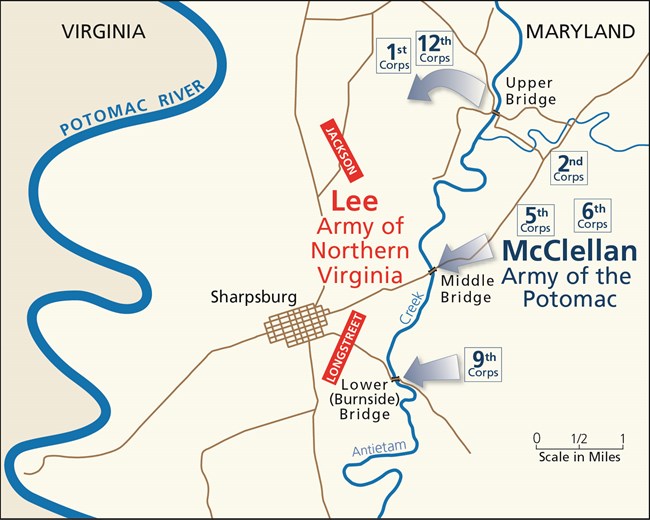Background - The Confederate DefensePark your car at Auto Tour Stop 9 and walk down the sidewalk to the patio overlooking Burnside Bridge.
McClellan’s plan was to “attack the enemy’s left,” and when “matters looked favorably,” attack the Confederate right, and “whenever either of those flank movements should be successful to advance our center.” Three stone bridges over Antietam Creek were key to this plan. Called Upper, Middle and Lower by army, theses bridges were crucial to the Union troops as the best possible locations to cross the creek and attack. McClellan directed the Union 9th Corps to take the Lower (later Burnside) Bridge and turn Lee’s right. 
Museum of the Confederacy As you stand here overlooking the bridge, it is obvious that the Confederates had the terrain advantage, however they were terribly outnumbered. Jones’ Division numbered about 3,300. Burnside had available close to 12,000 Union soldiers. Toombs placed the 2nd and 20th Georgia Infantry at the bridge. The 50th Georgia covered the ford downstream with help from two companies of South Carolinians. Toombs’ small command of about 500 soldiers spread out along the hillside you are standing on and poured their fire into Burnside’s men as they approached. Brig. Gen. David R. Jones was born in South Carolina, raised in Georgia and graduated from West Point in 1846. His classmates included Gen. George B. McClellan. He was 37 years old at Antietam and was nicknamed “Neighbor”Jones for his friendly, outgoing personality. Do you think he knew that his brother-in-law Henry Kingsbury, a Colonel in the Union army, was on the opposite side of the creek? Eyewitness"The strength [of the Confederate position] lay in the fact that the nature of the ground on the other side, the enemy were compelled to approach mainly by the road which led up to the river for near 300 paces parallel with my line of battle and distant therefrom from 50 to 150 feet, thus exposing his flank to a destructive fire for most of that distance.” Brig. Gen. Robert Toombs
Walk across the Burnside Bridge and turn left (north) and follow the trail along the stone wall to Stop 1.
|
Last updated: February 27, 2021
